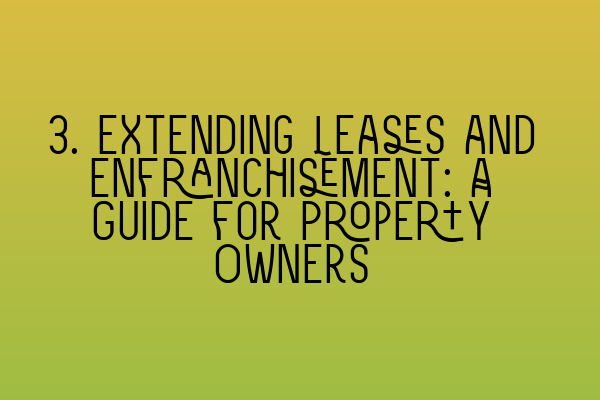3. Extending Leases and Enfranchisement: A Guide for Property Owners
Are you a property owner looking to extend your lease or explore the possibility of enfranchisement? The process can sometimes be complex and overwhelming, but fear not! In this comprehensive guide, we will walk you through the essential information and steps involved in extending leases and enfranchisement, empowering you to make informed decisions about your property.
Before we dive into the details, let’s briefly define the terms “extending leases” and “enfranchisement”.
What is Extending Leases?
Extending your lease involves increasing the length of time left on your lease agreement. This is particularly important if you own a leasehold property, as the value of your property can diminish as the lease term decreases. Extending your lease ensures that you have a greater control over your property and can also make it more appealing to potential buyers.
Now, let’s explore the steps involved in extending your lease:
1. Evaluation of Your Lease
The first step is to evaluate the terms of your current lease. This includes understanding the remaining length of the lease, ground rent obligations, and any other provisions that may affect the lease extension process. It is essential to review your lease in detail to ensure you fully understand your rights and options.
2. Engaging with a Solicitor
To navigate the lease extension process smoothly, it is recommended to engage with a solicitor who specializes in property law. An experienced solicitor will guide you through the legalities, offer expert advice, and ensure all necessary paperwork is completed accurately and efficiently.
3. Serving a Section 42 Notice
Once you have engaged a solicitor, they will assist you in serving a Section 42 Notice on your landlord. This notice formally advises the landlord of your intention to extend the lease and includes proposed terms for the extension. It is crucial to ensure the notice is drafted correctly and includes all necessary information to avoid potential delays.
4. Negotiating Terms
After serving the Section 42 Notice, negotiations regarding the terms of the lease extension will take place between you and the landlord. This may involve discussions on the premium payable for the extension, ground rent, and other lease terms. Having a skilled solicitor by your side during these negotiations can strengthen your position and help secure a favorable outcome.
5. Completing the Lease Extension
Once the negotiations have concluded and agreed terms have been reached, the lease extension can be completed. The completion process involves preparing and signing legal documents, including a new lease agreement. It is crucial to have your solicitor review the final documents before signing to ensure everything aligns with the agreed terms.
What is Enfranchisement?
Enfranchisement, on the other hand, refers to the process of acquiring the freehold interest in a leasehold property. This can give you outright ownership of the property and eliminate the need to pay ground rent or seek permission for certain alterations. Enfranchisement can be an attractive option, particularly for leasehold property owners who wish to have greater autonomy and control over their property.
Now, let’s explore the steps involved in the process of enfranchisement:
1. Evaluating Eligibility
The eligibility for enfranchisement can vary depending on the type of property and the number of qualifying tenants involved. It is essential to assess your eligibility and ensure that you meet the necessary criteria before proceeding with the process.
2. Forming a Collective Enfranchisement Company
To initiate the enfranchisement process, you will need to form a collective enfranchisement company comprising the qualifying tenants. This company will act as the entity through which the freehold interest will be acquired.
3. Serving a Section 13 Notice
Once the collective enfranchisement company is formed, a Section 13 Notice must be served on the landlord. This notice informs the landlord of the tenants’ desire to purchase the freehold and includes the proposed purchase price.
4. Negotiating the Purchase Price
Following the service of the Section 13 Notice, negotiations will take place between the tenants and the landlord to agree on the purchase price for the freehold. It is advisable to engage a surveyor to assess the property’s value and negotiate on your behalf to ensure a fair and reasonable price is determined.
5. Completing the Enfranchisement
Once an agreement on the purchase price has been reached, the legal process to complete the enfranchisement begins. This involves drafting and signing various legal documents, including a transfer document and new leases for individual flats. It is essential to seek guidance from a solicitor experienced in enfranchisement to ensure all legal requirements and procedures are met.
By now, you should have a clearer understanding of the process involved in extending leases and enfranchisement. Remember, seeking professional advice from a specialist property solicitor is key to navigating these processes effectively and achieving the best outcomes for your property.
Should you have any further questions or require assistance with extending your lease or enfranchisement, do not hesitate to contact SQE Property Law & Land Law. Our team of expert solicitors is dedicated to helping you make the most informed decisions about your property.
Related Articles:
SQE 1 Practice Exam Questions
SQE 1 Practice Mocks FLK1 FLK2
SQE 2 Preparation Courses
SQE 1 Preparation Courses
SRA SQE Exam Dates
